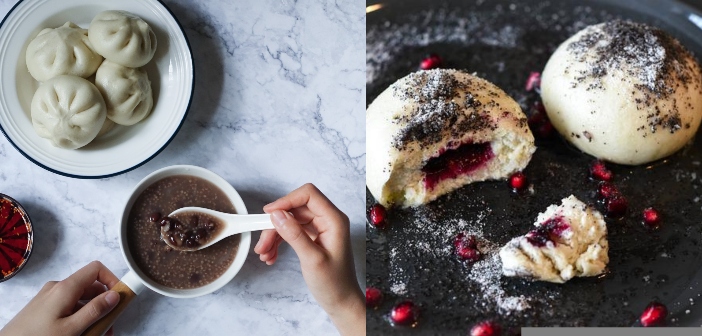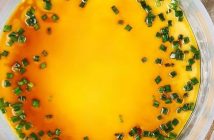Chinese people eat more frequently than Germans – on average seven times a day. That is what the German institution GIM (Gesellschaft für Innovative Marktforschung) found out in 2016 after they had asked 3,500 Chinese and German volunteers about their eating habits. According to the GIM, Chinese people are also more likely to try out new food than Germans.
But what about the dishes themselves? Let’s take a look at some of the most well-known accomplishments of German and Chinese cuisines, compare them, and find out how different they really are…
Baozi (包子) vs. Dampfnudeln

Germany and China might be thousands of miles apart, but at some point in history two people, separated by culture and country, must have had the same idea, because baozi (包子) and Dampfnudeln (lit. “steam noodles”) show a lot of similarities. Both are a kind of bread roll made of yeast dough that has to be steamed.
There are some differences, too, however: Dampfnudeln are usually much larger than baozi and, typically, you serve Dampfnudeln sweet. You fill them with jam and dip them in vanilla sauce. Baozi, on the other hand, are usually filled with vegetables and meat.
There are a lot of different kinds of baozi in China – for example mantou (馒头), a specialty of the Northern Chinese cuisine – but in Germany, there are only two variations of the Dampfnudel: The Bavarian version (sweet) and the Palatine one (salty). They both compete to be acknowledged as the original form of the Dampfnudel, but that will probably never be determined.
Zha Jiang Mian (炸酱面) vs. Käsespätzle

Käsespätzle (“cheese noodles” – once you know how to pronounce that correctly, you will have one more thing to show off about) and zha jiang mian are both dishes with a very long history. It is fair to say that in Swabia in Southern Germany, Käsespätzle are a part of the cultural identity – there is even a quite considerable amount of poetry based on Käsespätzle in Swabian literature. Zha jiang mian is a very traditional dish, too, especially in Beijing. According to legend, it was brought to the capital by an empress of the Qing dynasty who discovered zha jiang mian while travelling through China. She then found it so tasty that she brought the cook with her to Beijing.
Spätzle are a special sort of noodles made with egg. They are called Spätzle because each noodle is supposed to look a little bit like a sparrow (German: Spatz). There are tons of possibilities for how to serve Spätzle, but in Käsespätzle, they are always combined with melted cheese and roasted onions. Zha jiang mian, on the other hand, consists of thick noodles not mixed with cheese, but with a paste made of beans (for example soybeans) containing diced meat. Oftentimes it is served with raw vegetables.
Tu Dou Si (土豆絲) vs. Kartoffelpuffer

It is incredible how much mind power humankind has invested in inventing ways to serve potatoes. There are mashed, roasted, baked, and boiled potatoes. There is gratin, there is potato salad, and there are French fries.
And there are shredded potatoes.
Shredded potatoes are the key ingredients in both tu dou si and Kartoffelpuffer (a kind of potato pancake), also known as Rösti. But both dishes can contain other vegetables, too – usually carrots that are also shredded or sliced.
If you want to make tu dou si, you will have to fry the potato and the carrot slices. Adding pepper or dried chili will provide some spiciness. In order to prepare Kartoffelpuffer, the potatoes must be mixed with butter and eggs so that the ingredients merge into one mass, which then has to be roasted until it has formed a kind of crispy pancake.
So, what did we learn today? We learned that poetry about noodles exists (here is the link to a poem on Spätzle written in Swabian dialect, which is frankly quite hard to understand, even for Germans: Jeanette Hölzl’s homepage: ein schwäbisches Spätzle-Gedicht (holzl.de)) and we should also have learned that no matter in which culture we live, in the end, we all think very similarly: We will all invent something like baozi at some point in history, and we are all very imaginative when it comes to different ways to serve potatoes.
And I have learned a lot, too, researching for this article, thanks to Ayisha Wangsun, a girl who is a good cook and helped me quite a bit on this piece of work.
Images: Pexels, Dianping



